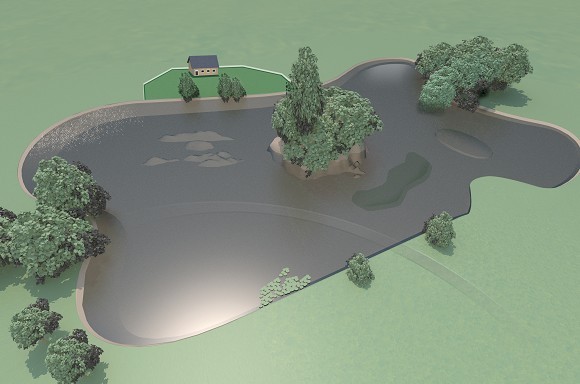
13 features to consider targeting on a gravel pit
This time around we’re looking at the key elements and sights for locating carp on a gravel pit
1 Snags
On any lake, snags are a huge feature to fish too. The carp will visit snags and use them as a sanctuary to get away from the angling pressure. Casting to the edges overhanging snags will often produce you a bite.
Top tip: When fishing up against snags make sure the fish can’t take any line by fishing a tight clutch and directly across to the snag. This stops them kiting and gaining sanctuary into the snag.
2 Weedbeds
Another place that carp will spend a lot of there time in the summer months is heavy weedbeds. This is because it offers them sanctuary and safety. The weed will also hold a lot of natural food.
Top tip Make sure your gear is up to the task of fishing a weedy water. Use a strong line of 15lb or above to cope with dragging back large lumps of greenery.
3 Points
Points can cover a very large amount of water. Being able to fish points and spread your rods about will often give you a good chance of intercepting a few fish. They also offer good visibility for spotting carp.
Top tip: Spread your rods right out and see if you can intercept fish. If you see fish showing out in front cast at them with a single hookbait.
4 Sunken roadways
In dry-dug pits, the areas and roadways the machinery used to get in and out of the pit are often used as feeding areas and navigation routes.
Top tip: Pin all of your rigs down with putty, as this will stop the fish from spooking out of the area
5 Silt traps
A build up of silt and sediment caused by wind and undertow creates silt deposits, which are often full of natural food like bloodworm. These can often be found between and behind gravel bars.
Top tip: Glug your hookbait and free-offerings in salmon oil (DT Bait’s Red Salmon Oil BPC) so it doesn’t take in the smell of the silt.
6 Inaccessible areas
Often areas where there is no swims or banks that are out-of-bounds to anglers will hold a lot of carp because they have learnt over time anglers rarely get baits into these areas. Either stalk or cast to these areas and catch the carp off guard.
Top tip: These are good areas to introduce bait so the carp can eat it without pressure and they can gain a liking for it.
7 Shallows
In the summer months the carp will often spend their time up in the water or in shallow and warm water. Find the shallower areas and you can often get takes off the bottom even in severe heat.
Top tip: Make sure you use a very slack line; a tight line will spook them out of the area.
8 Bars
Gravel bars are ridges formed by the massive scoops that extract gravel. These are used as underwater motorways by the carp and are good to fish on in the hotter weather because they can be some of the shallowest areas in the lake.
Top tip: Use some sort of a leader like tubing or leadcore to stop the fish cutting you off on the often-sharp gravel.
9 Gaps in the bars
Often enough if you find a system of bars, the silty areas that separate them are awesome places to put a rig. If the bars are steep the majority of all bait will roll down them and go into the silt. These are awesome ambush points which are very rarely fished.
Top tip: When fishing gaps in bars it is best to lengthen your hooklink. This is because there is often large deposits of silt in-between them.
10 Bays
Bays are a huge feature to the carp. Often when the main body of a lake gets busy they will go to small bays and coves to get away of the angling pressure. Keep an eye on bays that are on the end of a new and warm wind, as you will often find the carp stacked up in there!
Top tip: Keep an eye on these bays because they’re either full of carp or totally devoid of them. If you see fish in there, make a move.
11 Margins
No matter how big a lake is, one of the biggest features are the margins. The carp will often visit these for cover or when the weather warms up. When there is a strong and new wind blowing across a venue, you will often find them in the margin of the windward bank. Some features to look out for are reeds, lilies, overhanging trees and gravel humps.
Top tip: Bait up several spots before you fish and check them throughout your session to see if the carp are feeding on them.
12 Out-of-range areas
Often enough the areas at extreme-range will hold a lot of carp. The simple reason for this is most anglers cannot reach them by casting. If you can cast further than the other anglers on your lake, you stand a good chance of catching a few out-at-range when they are off their guard.
Top tip: To gain extra yards, use either a single hookbait or a very small PVA Stick. The further you can cast into these areas the better.
13 Windward banks
During the warmer weather, the carp are often found following a new and warm wind. If you see a new southwesterly coming in, make sure you get down your lake right in the teeth of it! The strong winds often churn the lakebed up on the windward margin too, which will attract the carp because of the abundance of natural food being brought up.
Top tip: Never neglect the margins here, you will often find the carp right in the edge!



